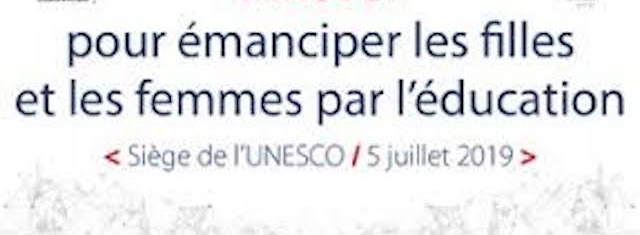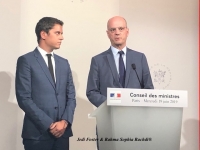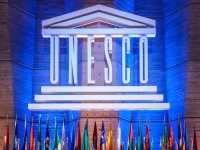Health
Half of G7 education aid is dedicated to gender equality
Resulatsare long overdue

UNESCO G7 Banner (Source: UNESCO)
USPA NEWS -
Despite significant progress made to close the gap between boys and girls in access to education worldwide over the last 20 years, the number of adult illiterate women in developing countries Low income has increased by 20 million since 2000, according to the latest UNESCO Global Monitoring Report on Education (GEM). The Building Bridges to Promote Gender Equality Report is presented at the G7 Meeting of Ministers of Development and Education and the G7-UNESCO International Conference at UNESCO Headquarters. It presents the very first data on G7 education support. According to the report, 55% of aid is allocated to gender equality, with Canada being the country with the highest budget (92%), followed by France and the United Kingdom, which respectively devote 76% their aid to the development of education.
The new Report also highlights significant disparities and uneven progress in different regions. One-third of countries do not offer the same opportunities to girls as boys in primary education.
The new Report also highlights significant disparities and uneven progress in different regions. One-third of countries do not offer the same opportunities to girls as boys in primary education.
Half of the countries in the world fail to offer equivalent lower secondary education for girls and boys, according to the report, which also highlights that only one in four countries offers identical upper secondary education for girls and boys. Sub-Saharan Africa is far behind at all levels of education and, for the first time, the Arab states are the most behind in terms of equality in primary education, perhaps because of conflict. Central Asia and South Asia have made great progress, driven by rapid changes in India. "Tackling inequality head-on is the only way to achieve quality education for all," said UNESCO Director-General Audrey Azoulay. "We welcome the G7 decision to focus on girls' education, a key UNESCO priority for the next six years. This is a positive development not only for the realization of a basic human right of girls and women, but also for all those who work for sustainable development and peace ".--------------------------------------------------------------------------
The report analyzes the 20 countries with the largest gaps in education between girls and boys and identifies their gender equality policies. Cash and in-kind rewards for families whose children attend school are the most popular policies implemented in three out of four national plans. Only one in five countries has taken steps to reform their curricula and textbooks, ensure girls' participation in science, technology, engineering and mathematics, or ensure safe access to schools. In Angola, the Central African Republic, Djibouti, and Mauritania, education plans make little reference to gender inequalities in education, but those in Niger, Guinea, and Somalia have strong roadmaps for education. change.
"We can try to improve education systems as much as we want, but it is unlikely that real change will occur unless we also address negative gender norms and attitudes in society," he said. warned Manos Antoninis, Director of the Global Education Monitoring Report. "More than a quarter of the population still thinks it's more important for a boy to go to college than a girl.
EMPOWERING GIRLS AND EDUCATE BOYS ARE NECESSARY FOR NEW MODELS--------------------------------------
We need to empower girls, educate boys and men, and identify new models if we want to challenge the status quo. "
Changing attitudes is all the more necessary to achieve parity, considering that 117 countries and territories still allow girls to marry and that four countries in sub-Saharan Africa apply a total ban on girls' return to school. school after pregnancy.
Inequality is also present in educational systems where education generally remains a female profession but where the positions of responsibility are occupied by men. In 28 countries, most of which have high incomes, 70% of junior secondary teachers are women, but women make up only 53% of school principals.Inequality affects girls and women in technical and vocational programs, which remain male bastions. Only a quarter of those enrolled in engineering and information and communication technology programs are women.-------------------------------------------------------------------------------------------
Gender inequality continues to hinder the development of girls and women to the detriment of all societies. UNESCO calls for greater political commitment to gender equality in the form of laws and policies. On 5 July, UNESCO will launch a global initiative entitled Education, Our Future to Encourage Cooperation on Three Key Pillars: Better Data, Better Policies and Best Practices for the Empowerment of Girls and Women by UNESCO education. As part of its advocacy for this initiative, UNESCO produced and put online an interactive map containing information on the state of national constitutions, laws and regulations on gender equality in countries around the world ( https://fr.unesco.org/education/girls-women-rights). Source G7-UNESCO
G7 Jean Yves Le Drian Foreign Affairs Ministry Brigitte Macron First Lady Jean Michel Blanquer Education Minister Unesco Jedi Foster Rahma Sophia Rachdi
Liability for this article lies with the author, who also holds the copyright. Editorial content from USPA may be quoted on other websites as long as the quote comprises no more than 5% of the entire text, is marked as such and the source is named (via hyperlink).







